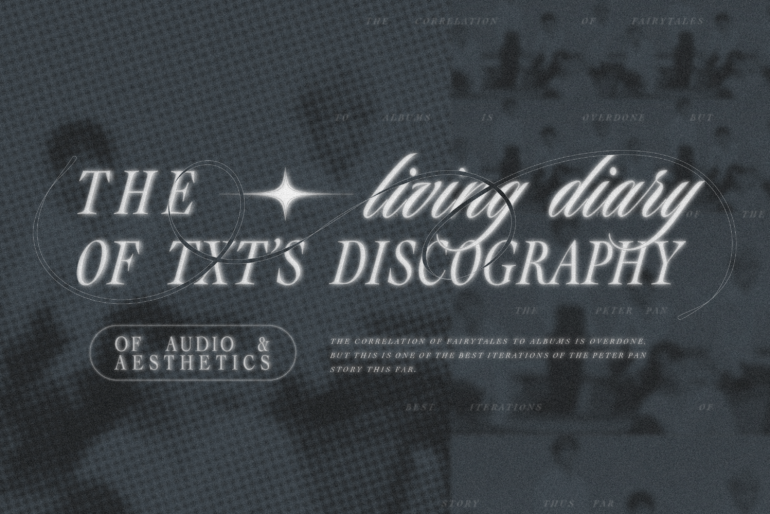There is an underrated truth to how visuals impact the experience of liking a song. I believe the K-pop industry understands this, delicately fretting over every aspect of performance to heighten the listening experience. What happens when these visuals draw inspiration from classic motifs?
Mixing fairytales and myths in a K-pop cauldron of fantasy isn’t new in the slightest. As seen with GFRIEND’s “Apple” borrowing from Snow White and ASTRO’s “Blue Flame” with Beauty and the Beast, it’s a combination that leaves many fans reminiscing their childhood nostalgia.
One specific tale that hasn’t escaped this reinvention is the Scottish tale of Peter Pan. The most recent reformation of this classic is taken to a new abstract level that fits within a bigger picture of concept and reflection on childhood sentimentality.
Enter Tomorrow x Together (TXT) and their newest EP, “The Name Chapter: Temptation.” With arbitrary actions on a dreamy island, imagination runs wild in their newest MV, but the sinister undertones are hard to ignore with the ever-present anti-drop and dark psychedelic visuals. To truly understand the influence this sickeningly nostalgic album has, TXT’s living discography must be called into examination.
Their idea can be seen from their full name alone, Tomorrow x Together, where each member comes together in hopes of creating a better tomorrow, but the storyline is where it gets really interesting. They follow the group through chapters, following the diary of the members trying to achieve their dream.
Each set of albums is combined into chapters or minisodes. The first three albums are within The Dream Chapter, including their debut album “Star.” These depict the shift from childhood to adolescence, where the five members come together in hopes of chasing one dream. Between each chapter is an EP that reflects on the motifs of the previous chapter, while acting as a bridge to the next. “Minisode 1: Blue Hour” contemplates the psychological development that occurred in the past three albums while acknowledging that the sun must set at this time. The next chapter, “The Chaos Chapter,” which followed the pandemic, expressed sentiments from when dreams were swept away and the reality of events set in. The next minisode pushes this motif to an extreme, showing the transition from adolescence to adulthood.
Now back to the current chapter, “The Name Chapter: Temptation,” which explores how temptation of freedom and lack of responsibility inhibits people. Each song acts as a few pages in their storybook, delivering the progression of their journey forward.
The opening song, “Devil by the Window,” introduces a demon as a sickeningly sweet temptation, telling them to give up on their dreams. It directly references their Blue Hour minisode discussing how the blue hour of final light ended, now erupting the darkness of crimson skies. “Sugar Rush Ride” indulges this, yielding to the temporary ecstasy this false sense of freedom delivers. “Happy Fools (ft. Coi Leray)” continues explaining the euphoria found in laziness, leading them to a dream-like guilty pleasure.
The final two songs carry the most weight in the narrative, beginning with Tinnitus (Wanna be a rock). The lyrics examine the detrimental and suffocating nature that giving into temptation fosters. Using lyrical metaphors like being a “rockstar minus the star” leaves them as lonely as a rock. It alludes to their debut album, where star was synonymous with their initial dream, and how that has now been destroyed.
Ending with Farewell, Neverland, the members decide to fight against the temptation of childhood freedom, realizing they must grow up. It doesn’t end with a happy revitalization to go back to their dream, instead accepting that their original dream was an illusion of innocence. For them to truly accomplish what they plan, they must reevaluate their dream to ensure it isn’t a paradise of irresponsibility. It’s an ending to an album that doesn’t sugar-coat anything.
This entire album is based on Neverland, and it’s noticeable in the music video and lyrical motifs. The demon (Peter Pan) comes in the night to take them away to an island of their own destruction. They explore the falseness of forever childhood, discussing how “a kiss from the sun that never sleeps” sounds pleasant but doesn’t allow them to ever see the dreams they had. They must let go of the unrealistic parts of dreams but not give up on them completely. There is a final realization and separation that is needed to move on, which allows this album to act as a final goodbye to childhood.
The correlation of fairytales to albums is overdone, but this is one of the best iterations of the Peter Pan story thus far. It isn’t used as a crutch to tell the story, but as a loose metaphor to further an already present narrative. Being the same age as the youngest two members of the group really cements the concept to me. Their direct response to what they feel as they grow up is relatable for anyone in the same age range.
Everything about this album is perfect to me, which is a rare case for my aspiring critic tendencies. The concept is perfectly executed, from the LSD-inspired music video to the trendy graphic design. The only thing that could make it better would be me on the graphics team.
Words and Graphic by Fai McCurdy.

